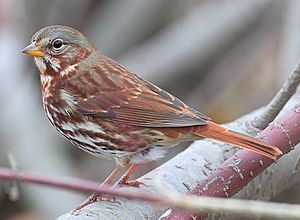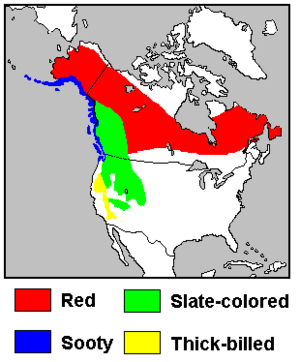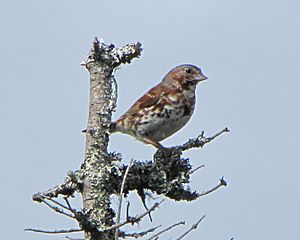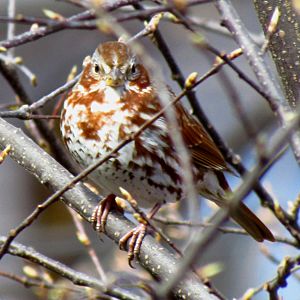Red fox sparrow facts for kids
Quick facts for kids Red fox sparrow |
|
|---|---|
 |
|
| Probable eastern fox sparrow Passerella iliaca iliaca |
|
| Scientific classification |
|
| Kingdom: | Animalia |
| Phylum: | Chordata |
| Class: | Aves |
| Order: | Passeriformes |
| Family: | Passerellidae |
| Genus: | Passerella |
| Species: | |
| Subspecies: |
P. i. iliaca
|
| Trinomial name | |
| Passerella iliaca iliaca (Merrem, 1786)
|
|
 |
|
| Breeding ranges of the four fox sparrow groups | |
The Red Fox Sparrow is a beautiful bird known for its bright colors. It belongs to a group of birds called American sparrows. Scientists call this specific group the Passerella iliaca iliaca group.
Contents
About the Red Fox Sparrow
The Red Fox Sparrow is a type of fox sparrow. Scientists have long thought it might be its own unique species. Studies of its DNA (the genetic material that makes each living thing unique) show that it is indeed a special group. It seems to be an early branch in the fox sparrow family tree.
What Does a Red Fox Sparrow Look Like?


The Red Fox Sparrow is a fairly large sparrow. It is about 15 to 19 centimeters (6 to 7.5 inches) long. Its wings can spread up to 27 centimeters (10.5 inches) wide. On average, it weighs about 32 grams (1.1 ounces).
Its head is gray, with a reddish-brown cap and ear patches. The throat is white, with a reddish-brown stripe on each side. The lower part of its beak is yellow, while the top part changes from yellow to black.
The chest has reddish-brown streaks that form a messy spot in the middle. These streaks continue down its sides, but its belly is usually white. A key way to identify this bird is by the clear reddish-brown and gray streaks on its back, along with a gray rump. Male and female Red Fox Sparrows look very similar.
What Does a Red Fox Sparrow Sound Like?
The Red Fox Sparrow has a loud call. People describe its voice as sounding like a "loud smack," similar to a brown thrasher.
Red Fox Sparrow Behavior
Reproduction and Life Cycle
Red Fox Sparrows build their nests in a wide area across northern forests. This area stretches from Newfoundland all the way to northern Alaska. They like to breed in dense groups of willow and alder bushes. They also like spruce and fir tree bogs.
These sparrows can build their nests on the ground. They also build them in shrubs and trees, usually less than 2 meters (6.5 feet) high. A female sparrow usually lays 3 to 5 eggs. The eggs are pale blue or pale green and have many brown spots.
The eggs hatch in about 12 to 14 days. The female bird does most of the egg sitting. However, both parents help feed the young birds. The baby birds are born helpless and need their parents' care. They are ready to leave the nest in 9 to 11 days.
Wintering and Migration
Red Fox Sparrows spend their winters in warmer parts of North America. This includes the northern United States and southern Canada. During their migration, they often stop over in these areas before flying further south.
Their spring migration north begins around February. By early May, almost all the birds have returned to their breeding grounds. In the fall, they start flying south around early October. By mid-November, only a few birds are still left in the northern areas.
Where Do Red Fox Sparrows Live?
There are slight differences among Red Fox Sparrows depending on where they live. For example, the Yukon Fox Sparrow (Passerella iliaca zaboria) has a slightly grayer head. It also has a browner stripe on its cheek compared to the Eastern Fox Sparrow (Passerella iliaca iliaca).
It can be hard to tell these two types apart in the wild. This is because their differences are small, and they don't stay in one place all year. However, they live in different areas, with only a small place where their ranges overlap.
This overlap area is roughly between the Nelson River and the lower Churchill River in Manitoba during the summer. In winter, the Mississippi River and the US states of Alabama and Georgia roughly mark the boundary between their ranges.
The Eastern Fox Sparrow (P. i. iliaca) lives from southern Wisconsin and Ontario east to Massachusetts. It then follows the coast north to southern Canada. It also ranges south to the Gulf of Mexico and northern Florida. The Yukon Fox Sparrow (P. i. zaboria) lives from southeastern Minnesota to the Great Plains. It ranges south to Texas and east to the overlap zone mentioned earlier.

